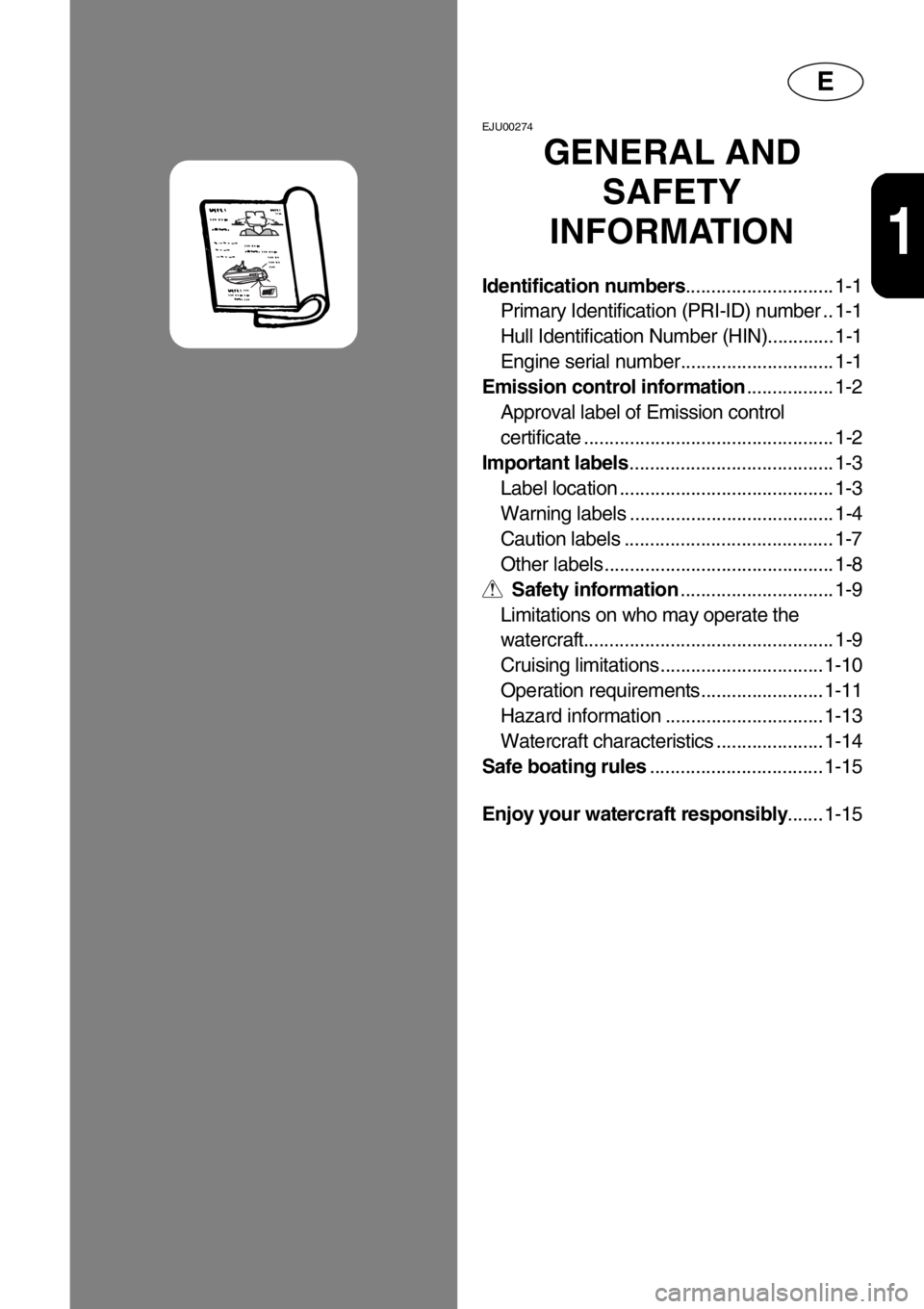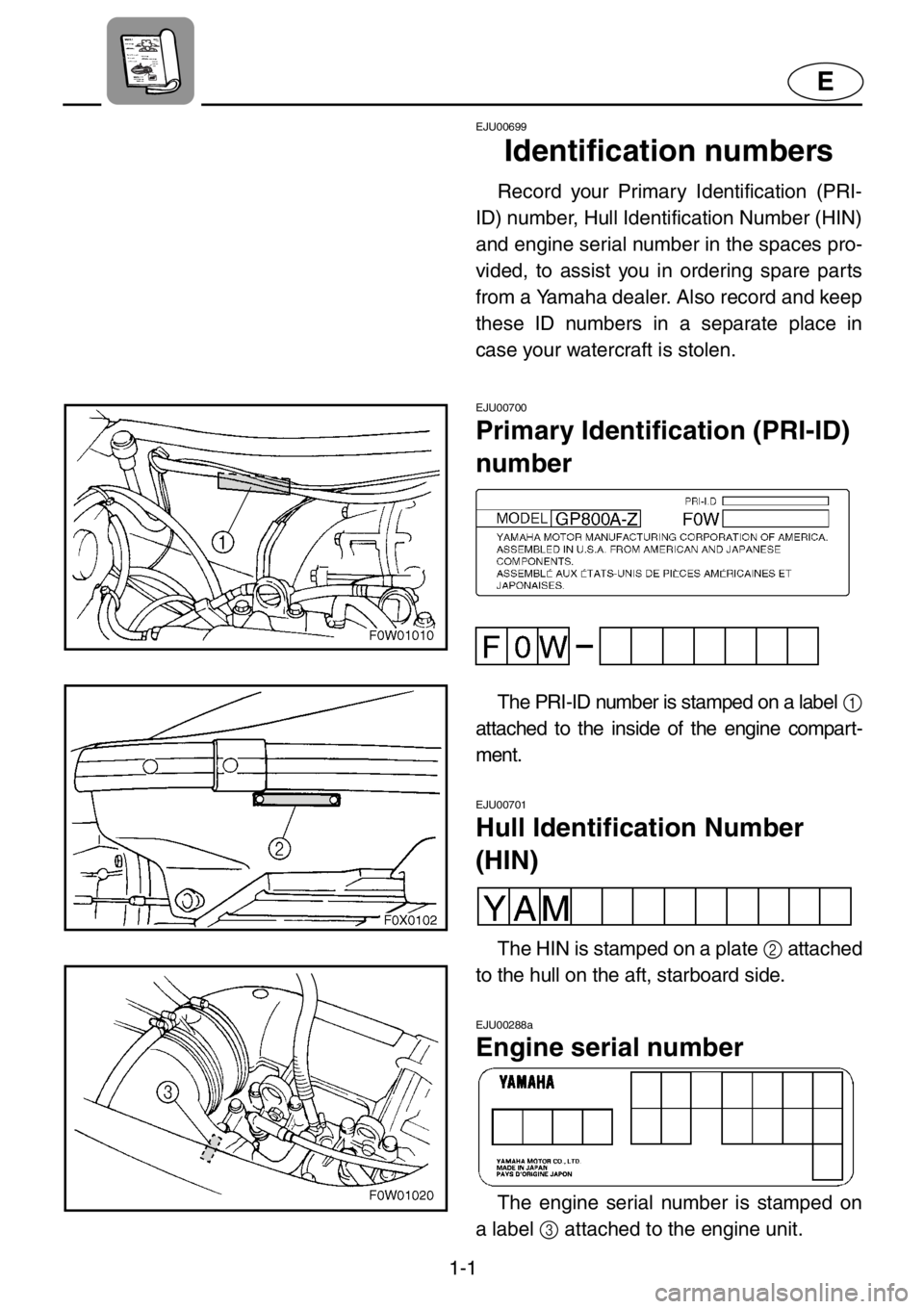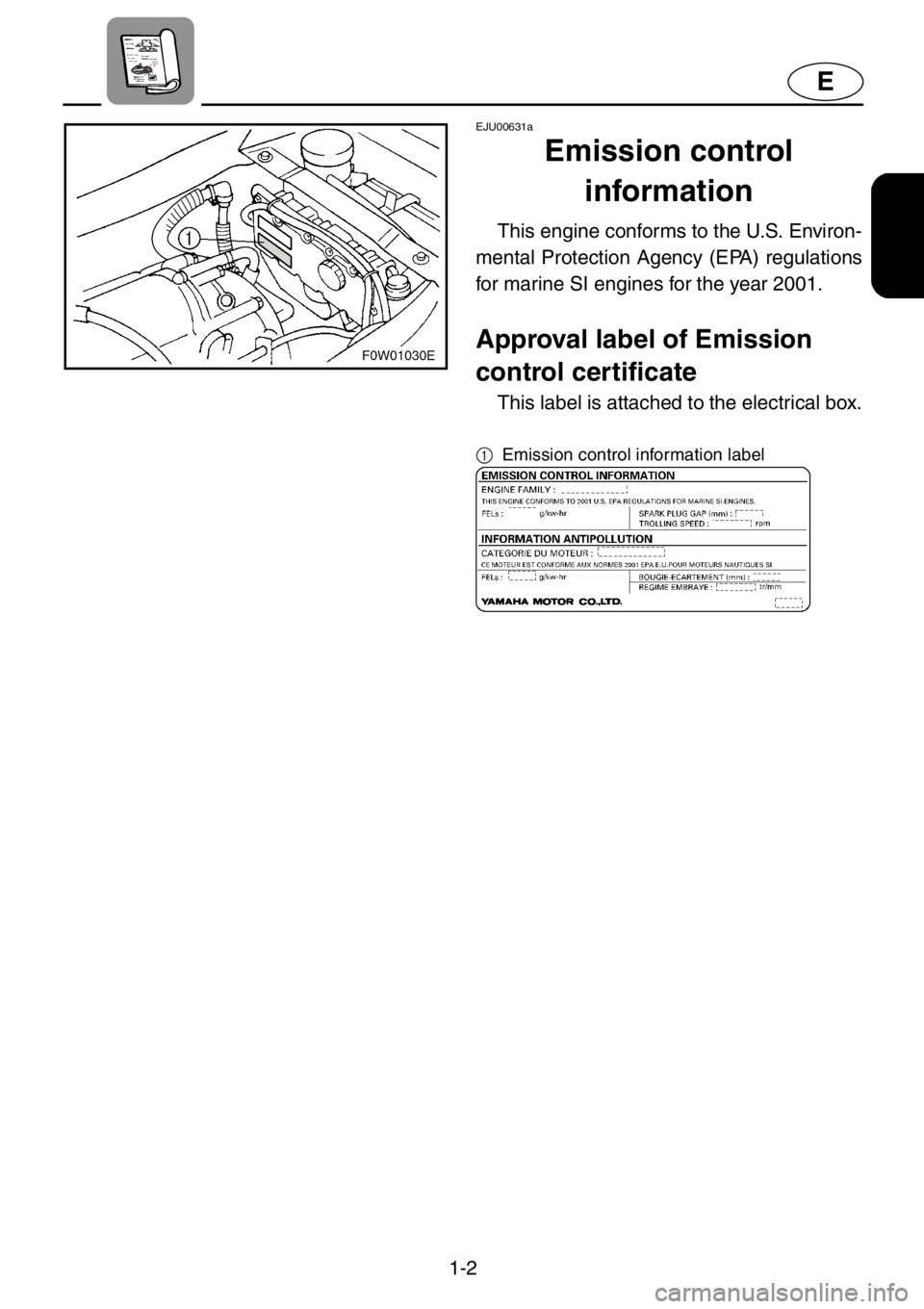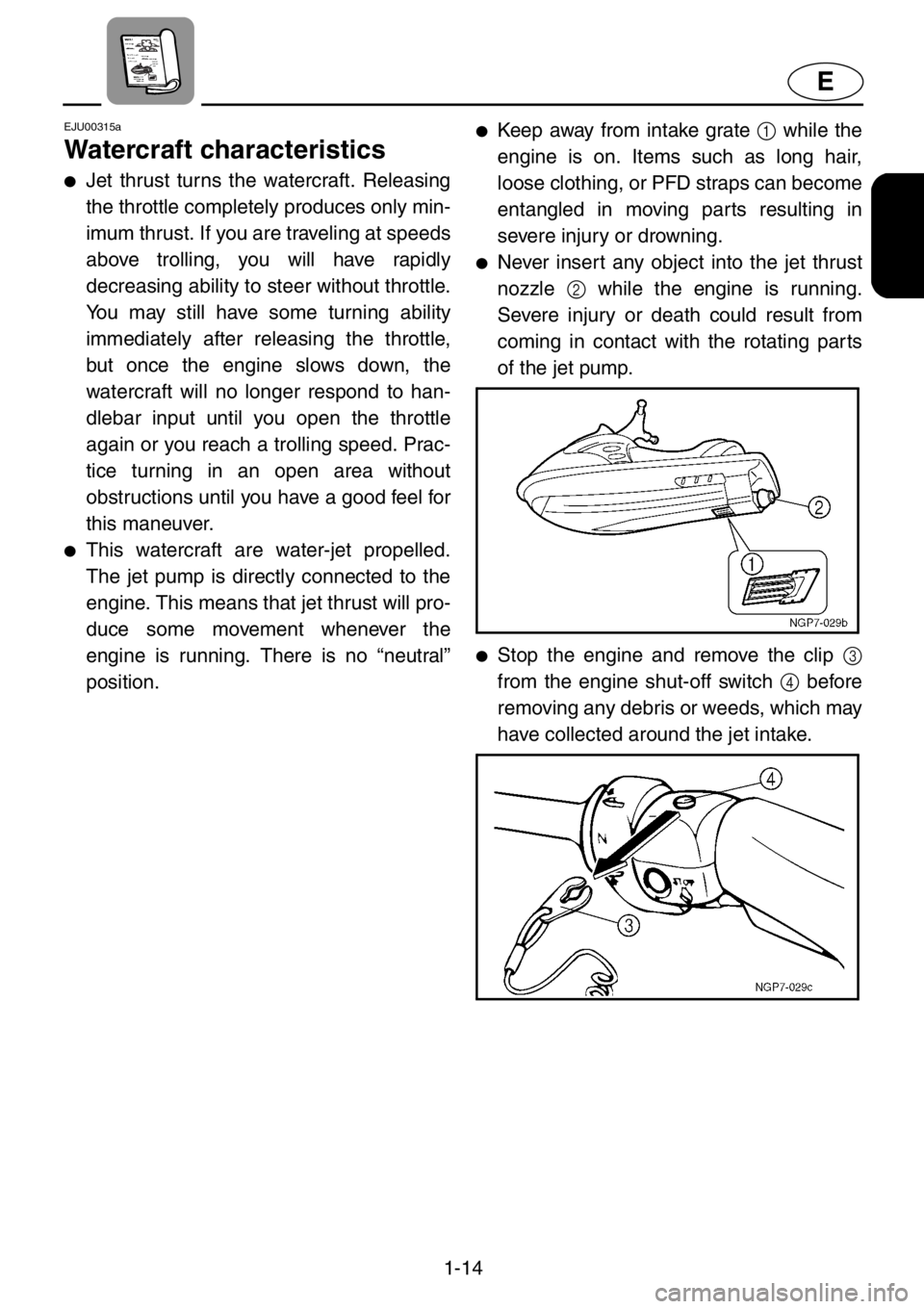engine YAMAHA GP800R 2021 Owners Manual
[x] Cancel search | Manufacturer: YAMAHA, Model Year: 2021, Model line: GP800R, Model: YAMAHA GP800R 2021Pages: 119, PDF Size: 13.2 MB
Page 7 of 119

E
1
EJU00274
GENERAL AND
SAFETY
INFORMATION
Identification numbers............................. 1-1
Primary Identification (PRI-ID) number .. 1-1
Hull Identification Number (HIN)............. 1-1
Engine serial number.............................. 1-1
Emission control information................. 1-2
Approval label of Emission control
certificate ................................................. 1-2
Important labels........................................ 1-3
Label location .......................................... 1-3
Warning labels ........................................ 1-4
Caution labels ......................................... 1-7
Other labels ............................................. 1-8
Safety information.............................. 1-9
Limitations on who may operate the
watercraft................................................. 1-9
Cruising limitations ................................ 1-10
Operation requirements........................ 1-11
Hazard information ............................... 1-13
Watercraft characteristics ..................... 1-14
Safe boating rules.................................. 1-15
Enjoy your watercraft responsibly....... 1-15
Page 8 of 119

1-1
E
EJU00699
Identification numbers
Record your Primary Identification (PRI-
ID) number, Hull Identification Number (HIN)
and engine serial number in the spaces pro-
vided, to assist you in ordering spare parts
from a Yamaha dealer. Also record and keep
these ID numbers in a separate place in
case your watercraft is stolen.
EJU00700
Primary Identification (PRI-ID)
number
The PRI-ID number is stamped on a label 1
attached to the inside of the engine compart-
ment.
EJU00701
Hull Identification Number
(HIN)
The HIN is stamped on a plate 2 attached
to the hull on the aft, starboard side.
EJU00288a
Engine serial number
The engine serial number is stamped on
a label 3 attached to the engine unit.
Page 9 of 119

1-2
E
EJU00631a
Emission control
information
This engine conforms to the U.S. Environ-
mental Protection Agency (EPA) regulations
for marine SI engines for the year 2001.
Approval label of Emission
control certificate
This label is attached to the electrical box.
1
Emission control information label
Page 20 of 119

1-13
E
●Do not attempt to modify this watercraft!
Modifications to your watercraft may
reduce safety and reliability, and render
the watercraft unsafe or illegal for use.
●Attach the engine shut-off cord (lanyard)
to wrist and keep it free from the handle-
bars so that the engine stops if the opera-
tor falls off. After riding, remove the
engine shut-off cord from the watercraft to
avoid accidental starting or unauthorized
use by children or others.
●Scan carefully for swimmers and stay
away from swimming areas. Swimmers
are hard to see and you could acciden-
tally hit someone in the water.
●Avoid being hit by another boat! You
should always take the responsibility to
watch for traffic; other boaters may not be
watching for you. If they do not see you,
or you maneuver more quickly than other
boaters expect, you risk a collision.
●Maintain a safe distance from other boats
or watercraft, and also watch for boats’ ski
ropes or fishing lines. Obey the “Safe
boating rules” and be sure to check
behind you before making a turn. (See
Safe boating rules on page 1-14.)
EJU00313
Hazard information
●When transporting or storing your water-
craft, always place the fuel cock knob in
the “OFF” position, otherwise gasoline
may overflow from the carburetor.
●Never start the engine or let it run for any
length of time in an enclosed area.
Exhaust fumes contain carbon monoxide,
a colorless, odorless gas that may cause
loss of consciousness and death within a
short time. Always operate the watercraft
in an open area.
Page 21 of 119

1-14
E
EJU00315a
Watercraft characteristics
●Jet thrust turns the watercraft. Releasing
the throttle completely produces only min-
imum thrust. If you are traveling at speeds
above trolling, you will have rapidly
decreasing ability to steer without throttle.
You may still have some turning ability
immediately after releasing the throttle,
but once the engine slows down, the
watercraft will no longer respond to han-
dlebar input until you open the throttle
again or you reach a trolling speed. Prac-
tice turning in an open area without
obstructions until you have a good feel for
this maneuver.
●This watercraft are water-jet propelled.
The jet pump is directly connected to the
engine. This means that jet thrust will pro-
duce some movement whenever the
engine is running. There is no “neutral”
position.
●Keep away from intake grate 1 while the
engine is on. Items such as long hair,
loose clothing, or PFD straps can become
entangled in moving parts resulting in
severe injury or drowning.
●Never insert any object into the jet thrust
nozzle 2 while the engine is running.
Severe injury or death could result from
coming in contact with the rotating parts
of the jet pump.
●Stop the engine and remove the clip 3
from the engine shut-off switch 4 before
removing any debris or weeds, which may
have collected around the jet intake.
Page 23 of 119

E
2
EJU00326
FEATURES AND
FUNCTIONS
Location of main components............... 2-1
Operation of controls and other
functions.................................................... 2-5
Seat ......................................................... 2-5
Hood ........................................................ 2-6
Fuel tank filler cap ................................... 2-6
Oil tank filler cap...................................... 2-6
Fuel cock knob........................................ 2-7
Engine stop switch .................................. 2-8
Engine shut-off switch............................. 2-8
Choke lever ............................................. 2-8
Throttle lever ........................................... 2-9
Start switch.............................................. 2-9
Cooling water pilot outlet ...................... 2-10
Steering system .................................... 2-10
Quick Shift Trim System (QSTS)
selector .................................................. 2-11
Engine overheat warning system ......... 2-13
Handgrip................................................ 2-14
Multifunction information center........... 2-15
Tachometer ........................................... 2-16
Speedometer ........................................ 2-16
Reset button.......................................... 2-16
Fuel meter ............................................. 2-17
Hour meter ............................................ 2-17
Fuel warning indicator........................... 2-18
Oil warning indicator ............................. 2-18
Engine overheat warning indicator....... 2-18
Storage compartments ......................... 2-19
Yamaha Adjustable Sponson
(Y.A.S.) .................................................. 2-20
Page 26 of 119

2-3
E
1Engine shut-off cord (lanyard)
Attach to wrist so that the engine stops if the
operator falls off the watercraft.
2Engine stop switch
Push to stop the engine normally.
3Clip
Insert into the engine shut-off switch to enable
starting of the engine.
Remove to stop the engine or prevent acci-
dental star ting of the engine or unauthorized
use of the watercraft.
4Quick Shift Trim System (QSTS) selector
Use to select the trim angle of the watercraft.
5Engine shut-off switch
Remove the clip to stop the engine and dis-
able it from starting.
6Start switch
Push to start the engine.
7Multifunction information center
Use to check watercraft operation.8Throttle lever
Use to accelerate and decelerate.
9Choke lever
0Oil tank filler cap
AFuel cock knob
BStern drain plugs
Use to drain water in the bilge when the water-
craft is on dry land.
CJet thrust nozzle
Changes the direction of jet thrust according
to handlebar position.
DRide plate
Page 27 of 119

2-4
E
1Spark plugs/Spark plug caps
2Electrical box
Protects electrical components from water.
3Flush hose connector
Use to flush the engine cooling water pas-
sages.
4Spark plug lead
5Muffler
6Fuel filter
7Fuel tank8Oil tank
9Battery
0Fire extinguisher container
AWater separator
Page 30 of 119

2-7
E
EJU00704
Fuel cock knob
The fuel cock supplies fuel from the fuel
tank to the carburetors.
The fuel cock knob 1 positions are
explained as follows and are shown in the
illustration.
OFF:
With the fuel cock knob in this position,
fuel does not flow. Always turn the fuel cock
knob to this position when the engine is not
running.
ON:
With the fuel cock knob in this position,
fuel flows to the carburetors. Turn the fuel
cock knob to this position when starting the
engine and operating the watercraft.
RES:
This indicates reserve. With the fuel cock
knob in this position, the fuel reserve is
made available. Tur n the fuel cock knob to
this position if you run out of fuel while oper-
ating the watercraft. When this occurs,
refuel as soon as possible and be sure to
turn the fuel cock knob back to “ON”!
Page 31 of 119

2-8
E
EJU00705
Engine stop switch
Push this switch 1 (red button) to stop
the engine normally.
EJU00706
Engine shut-off switch
Insert the clip 1, on the end of the engine
shut-off cord 2, under the engine shut-off
switch 3 (black button). The engine will stop
automatically when the clip is removed from
the switch, such as if the operator falls off
the watercraft.
WARNING
●Always attach the engine shut-off cord
to your wrist and the clip to the engine
shut-off switch BEFORE starting the
engine.
●To prevent accidental starting of the
engine or unauthorized use by chil-
dren or others, always remove the clip
from the shut-off switch when the
engine is not running.
EJU00350
Choke lever
Starting a cold engine requires a richer
air-fuel mixture, which is supplied by the
choke.
Move the lever 1 in direction a to turn
the choke on.
Move the lever in direction b to turn the
choke off.